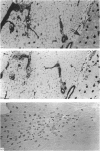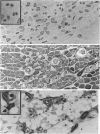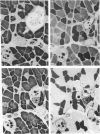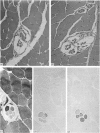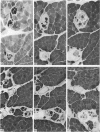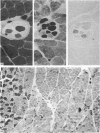Abstract
The various parts of the masseter muscle complex (pars superficialis, pars profunda, zygomaticomandibularis, maxillomandibularis) in the rat, guinea-pig, rabbit, cat and macaque monkey were examined to discover whether they showed any relationship between the distribution of muscle spindles and extrafusal fibre types. Intrafusal (spindle) and extrafusal fibre types in masseter were compared with those in limb muscles and were identified by a combination of standard histochemical methods and indirect immunoperoxidase staining with antibodies specific for the various isoforms of myosin characteristic of fibre types in mammalian muscle. In general, the fibre-type properties of intrafusal fibres in masseter resembled those in limb muscle spindles, but the extrafusal fibre-type composition was unlike that in most limb muscles. In the rat masseter, most of the spindles were clustered together in a few very restricted areas. Extensive fusion of the external capsules of adjacent spindles, resulting in the formation of giant spindles, was seen in the cat and monkey masseter; this was sometimes accompanied by the enclosure of extrafusal fibres within the fused spindles. Common to all species, but strongest of all in the rat, was a close association between the distributions of muscle spindles and extrafusal Type I (slow twitch) fibres within the masseter complex. Muscle spindles and Type I fibres were either absent or rarest in the superficial part of masseter, but were most common in the deep layer (pars profunda) or zygomaticomandibularis. The functional significance of these observations is discussed.
Full text
PDF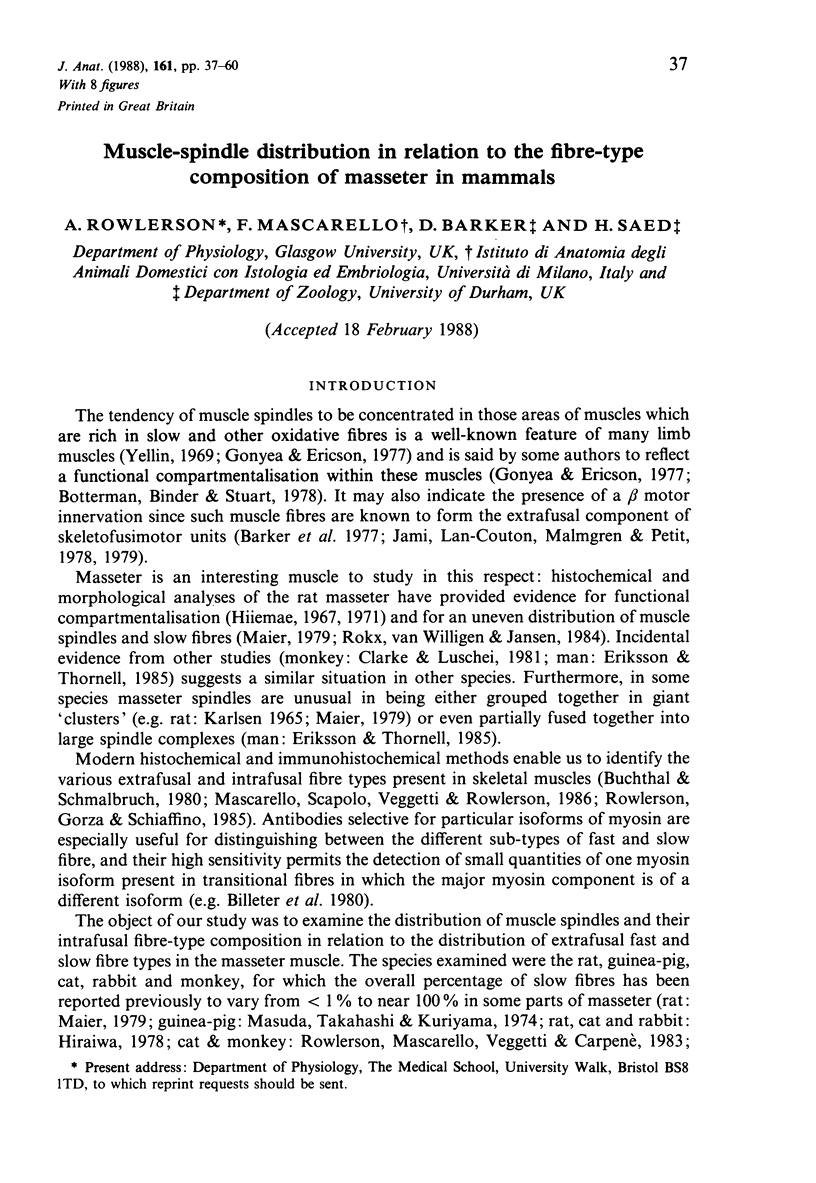
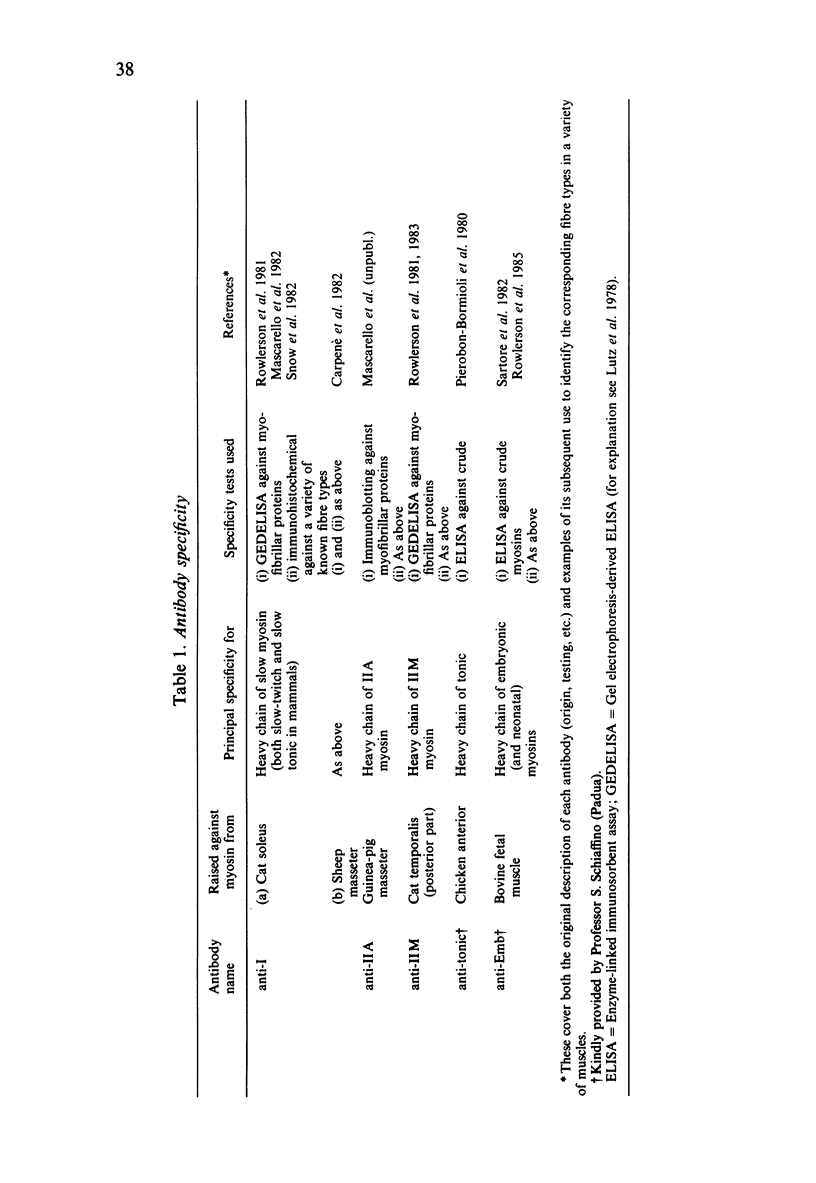
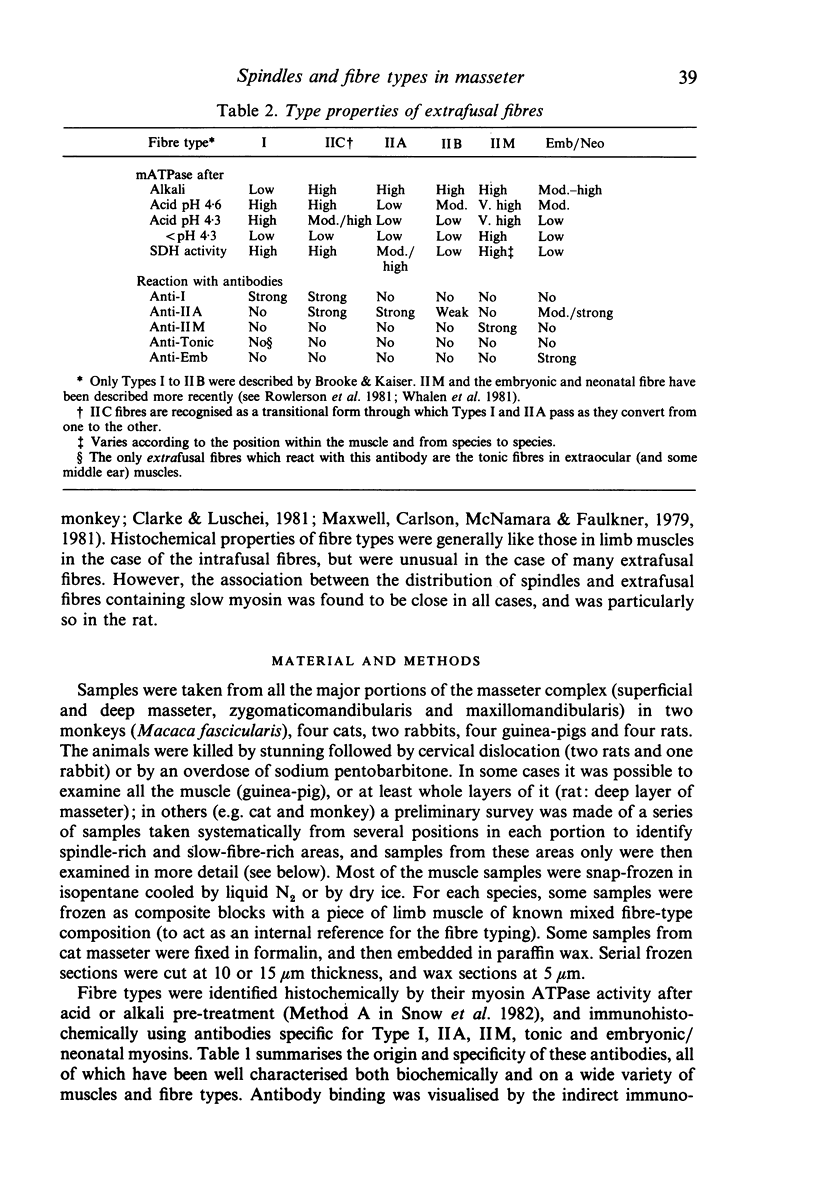
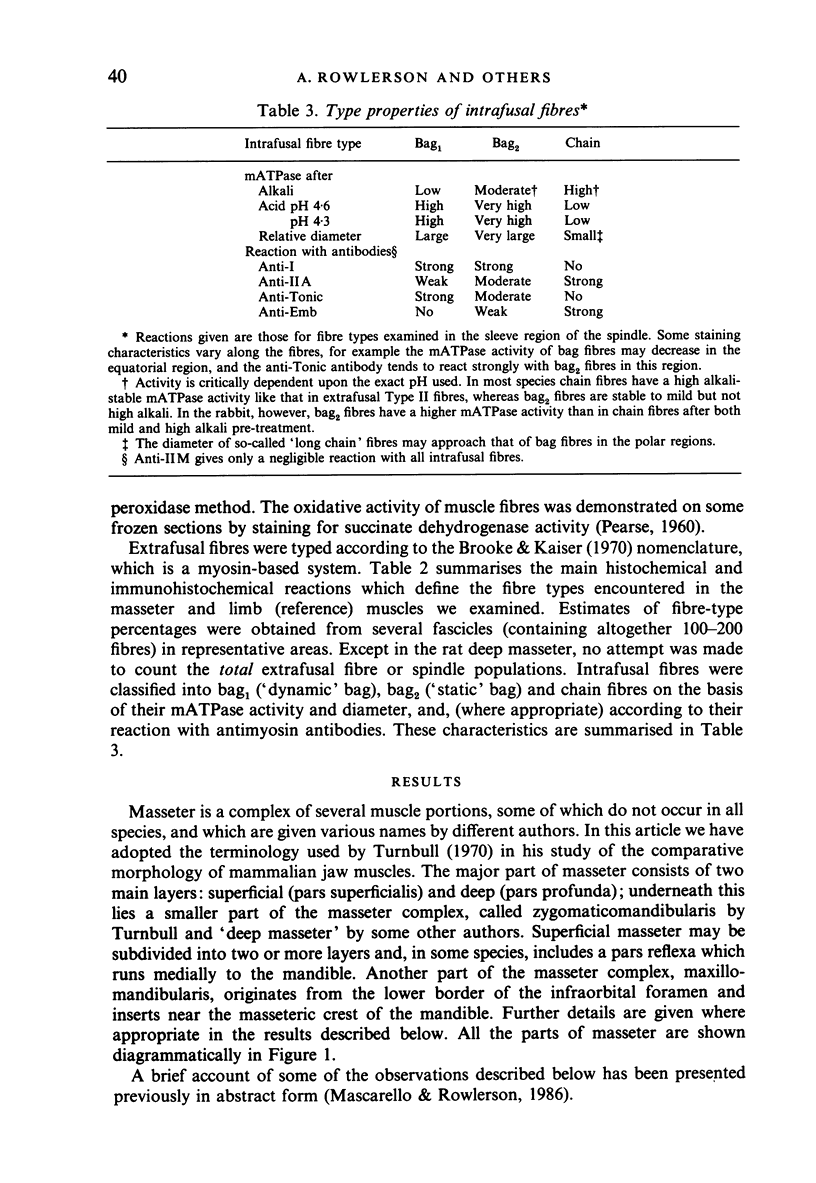
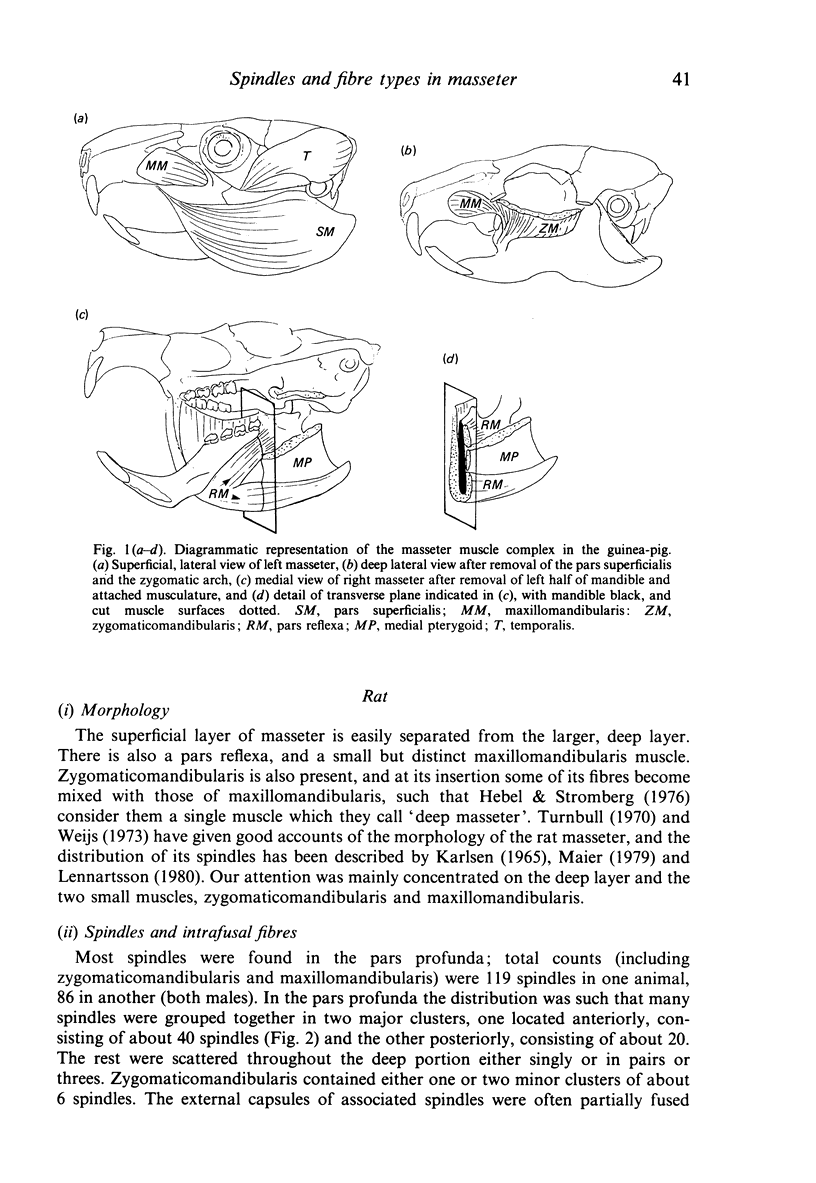
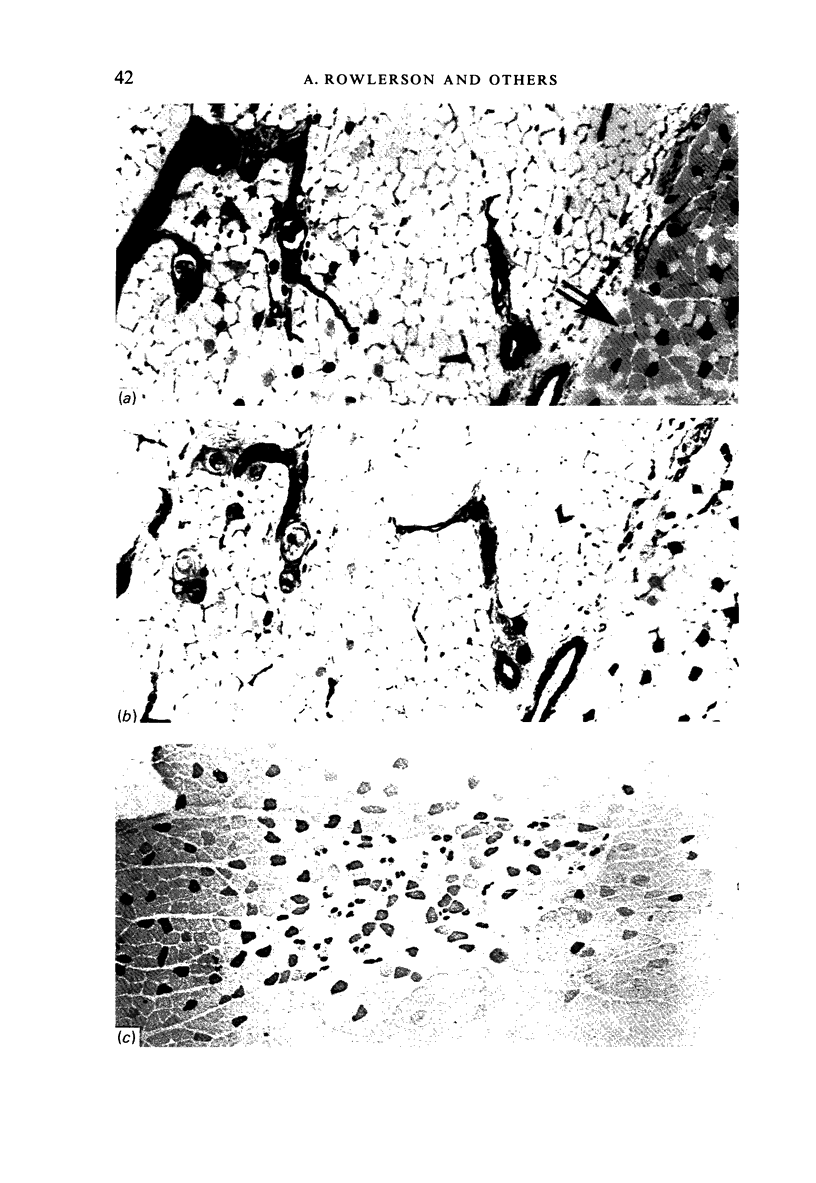
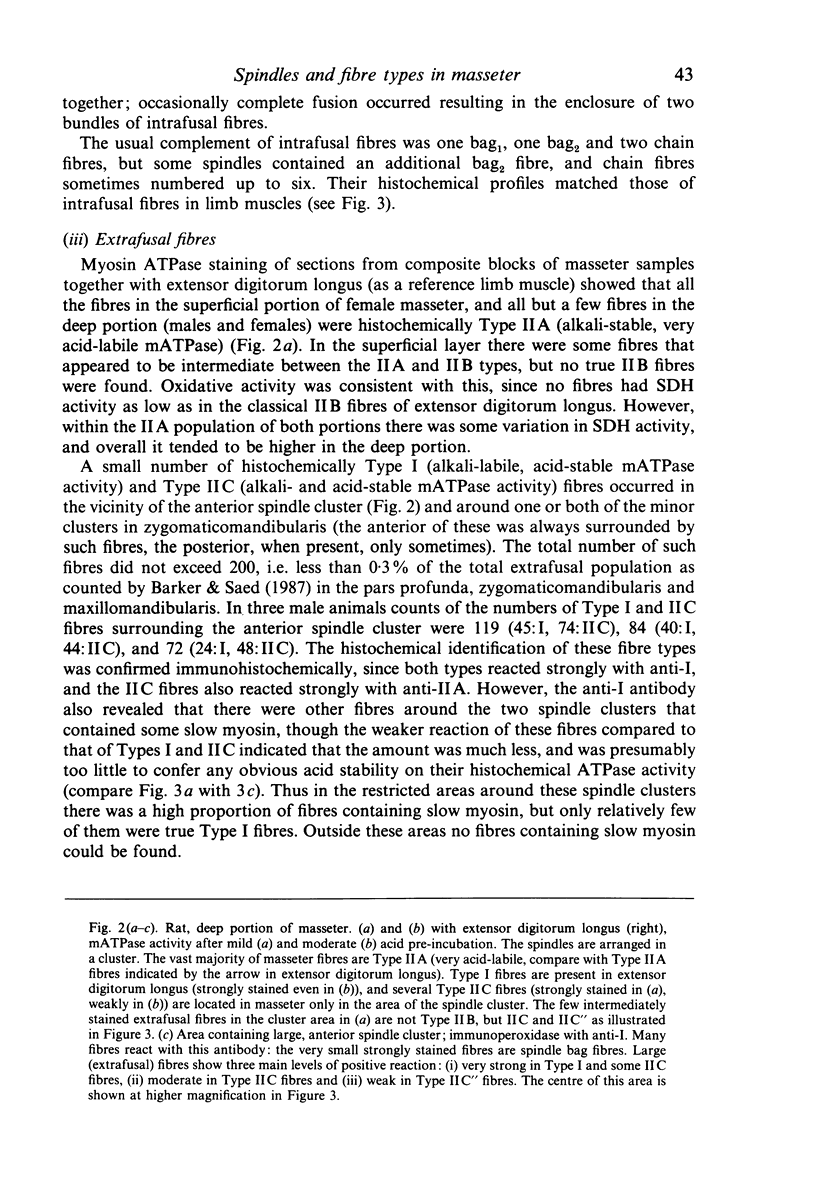
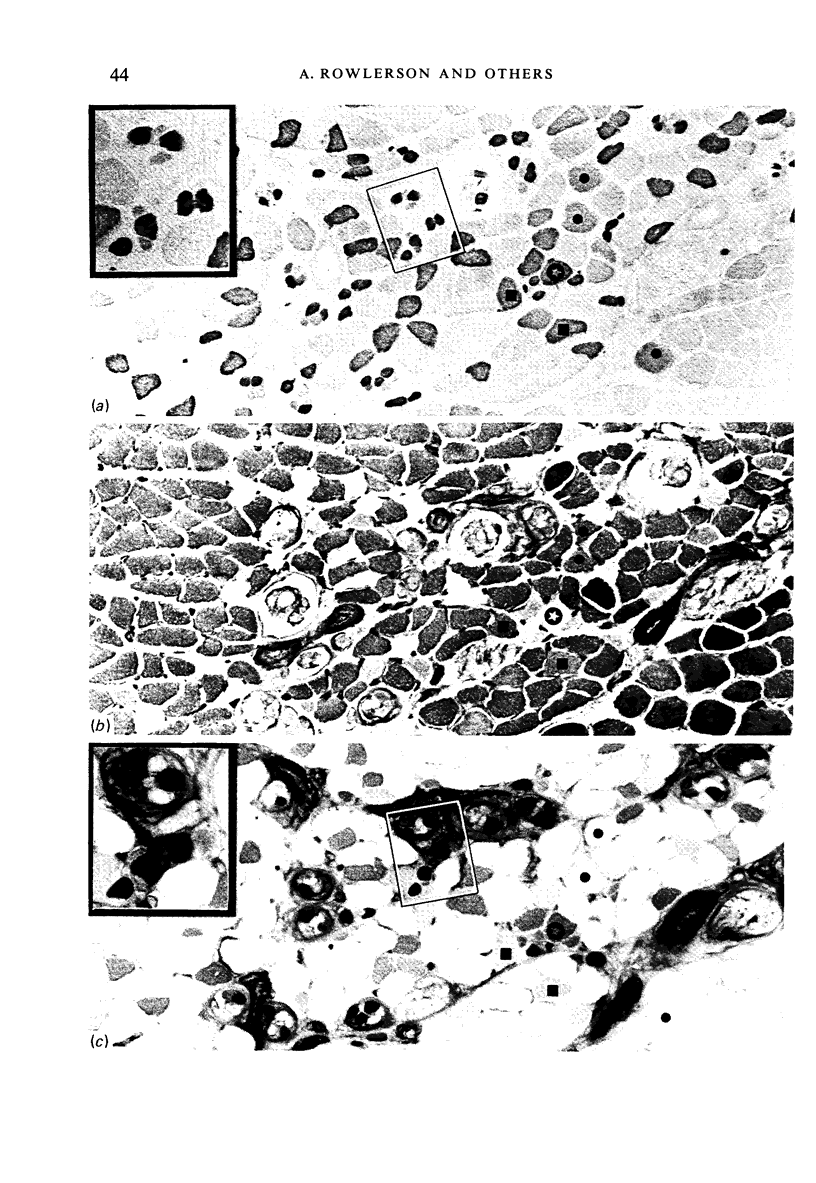
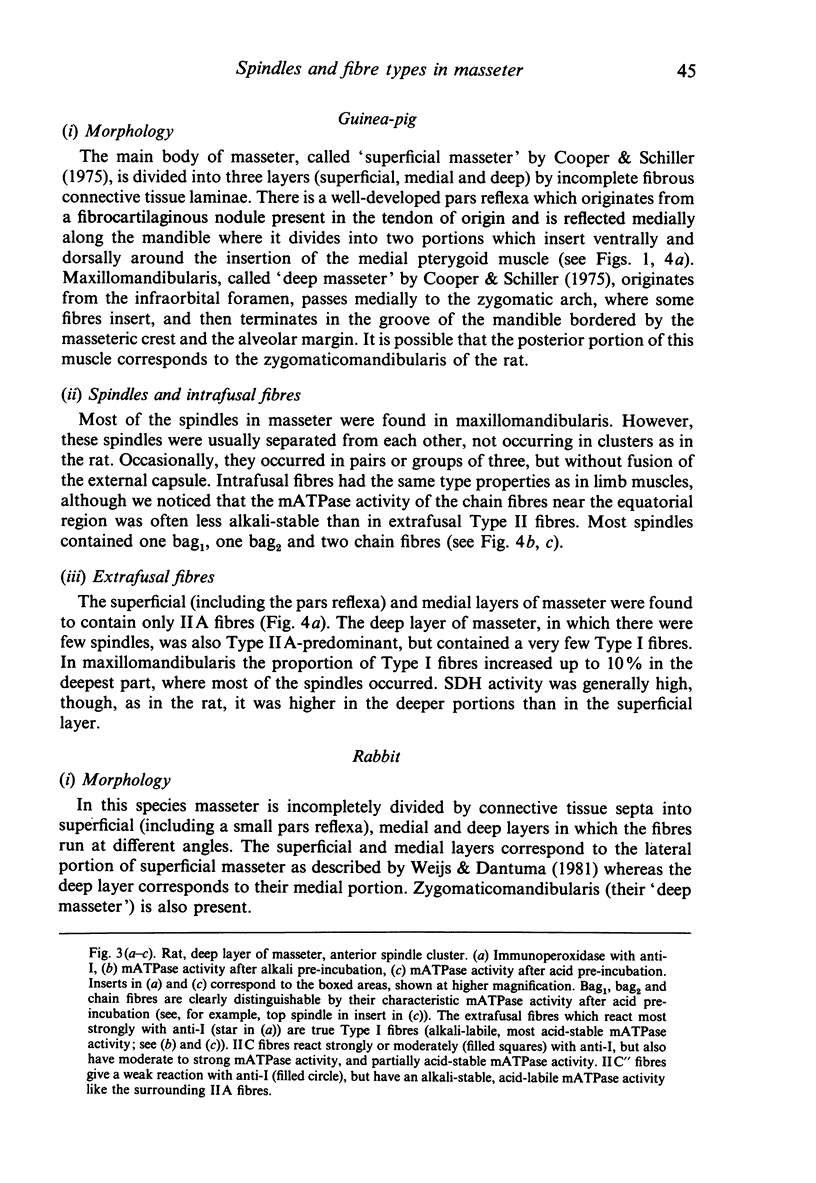
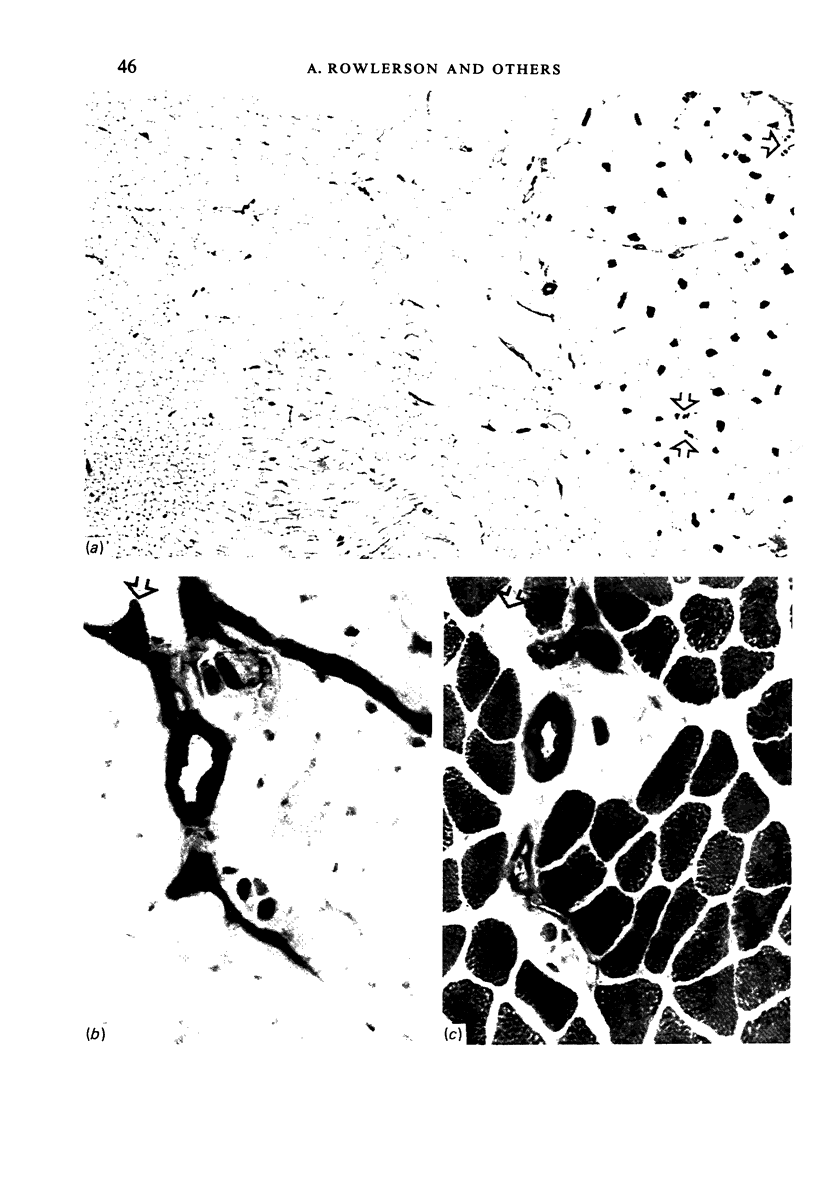
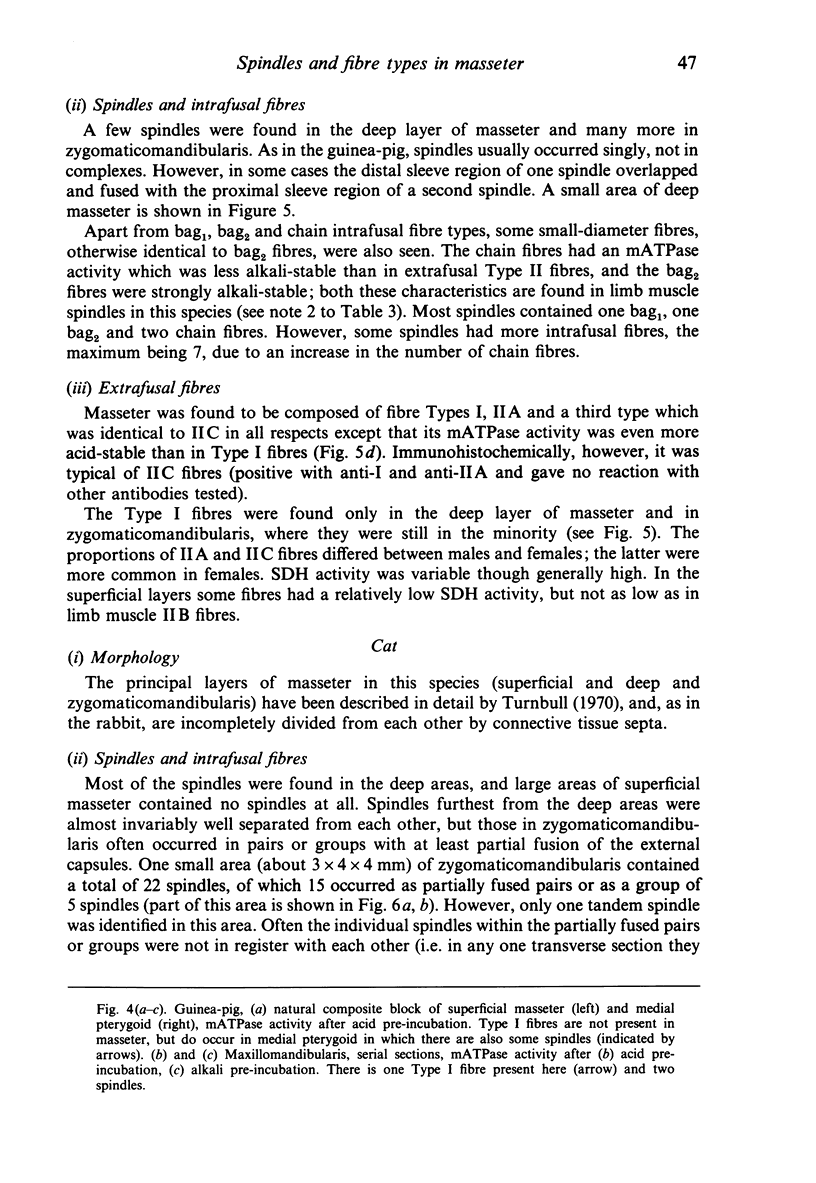
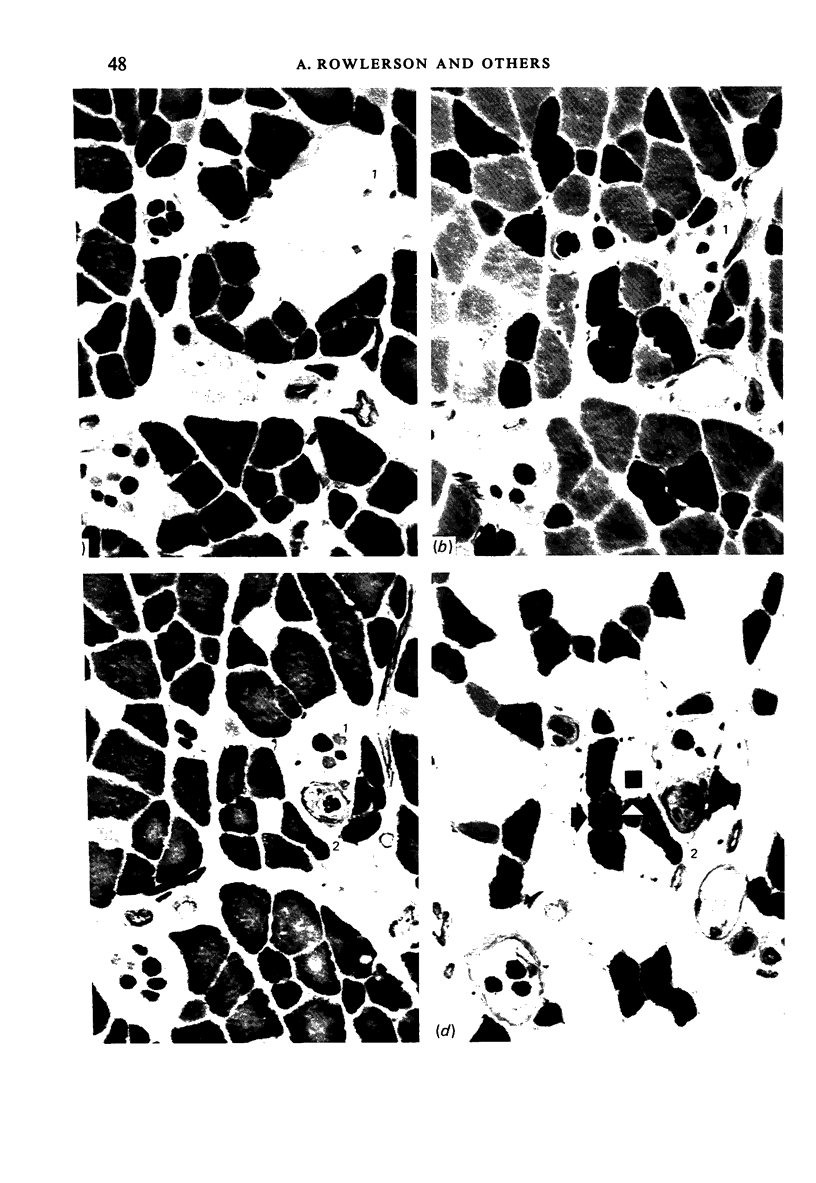
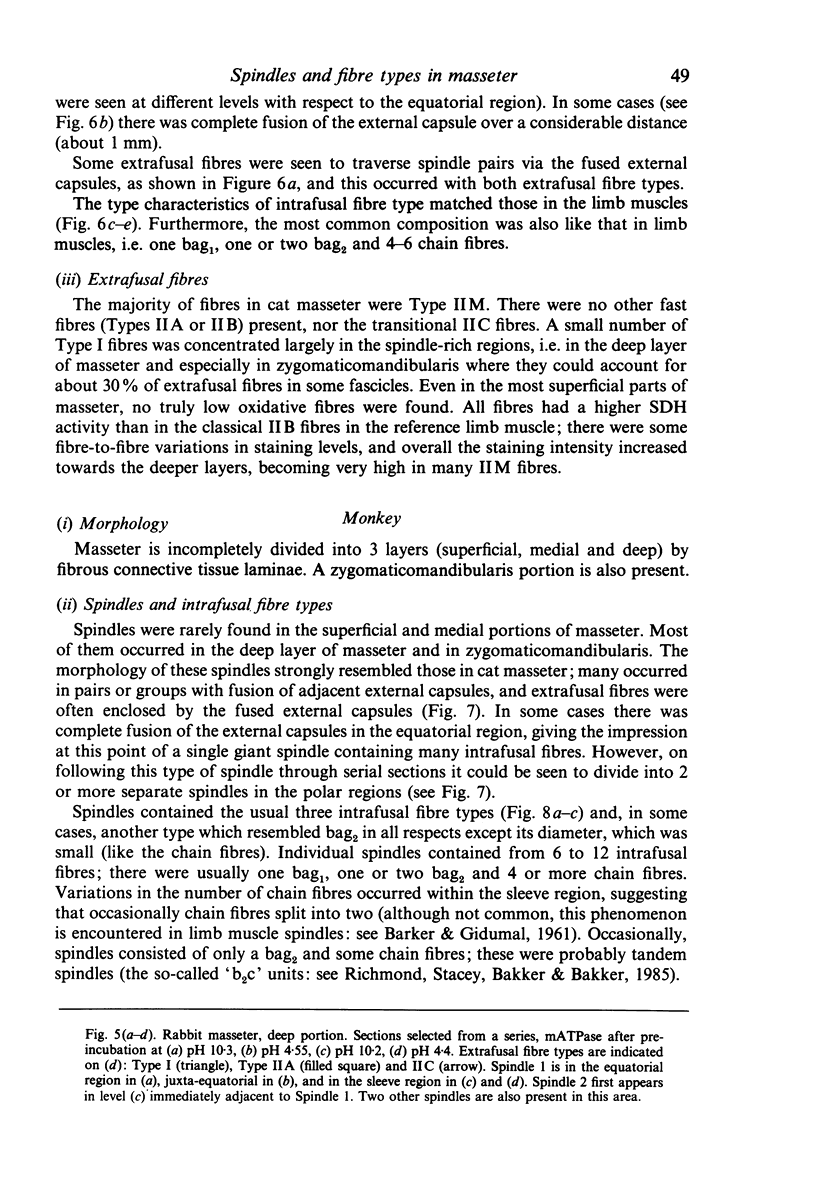
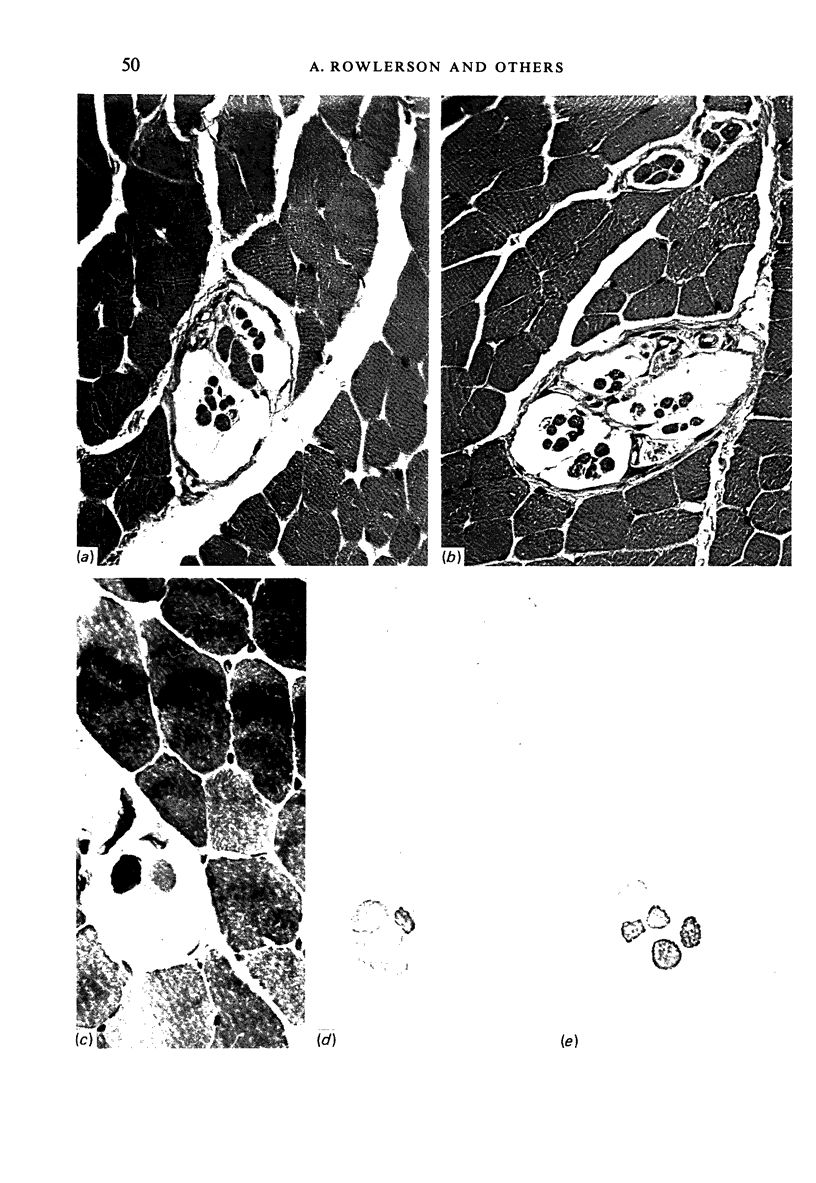
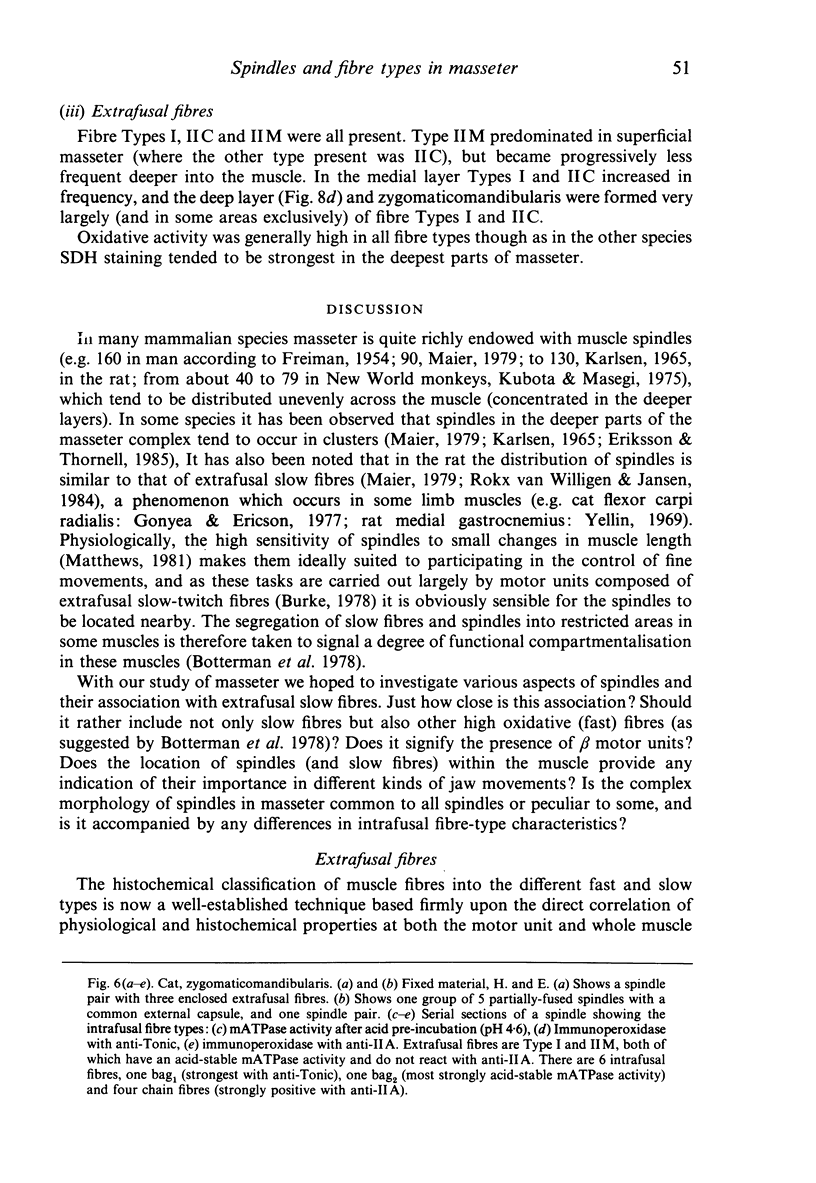
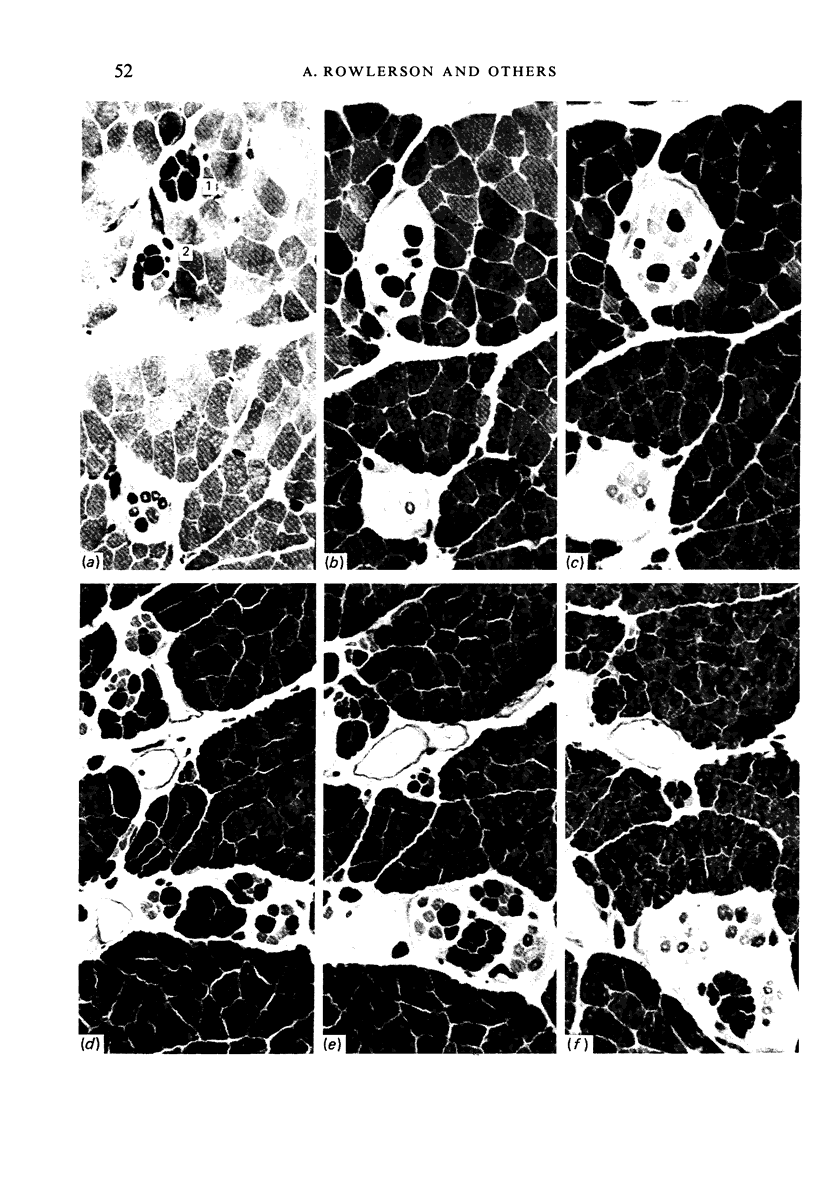
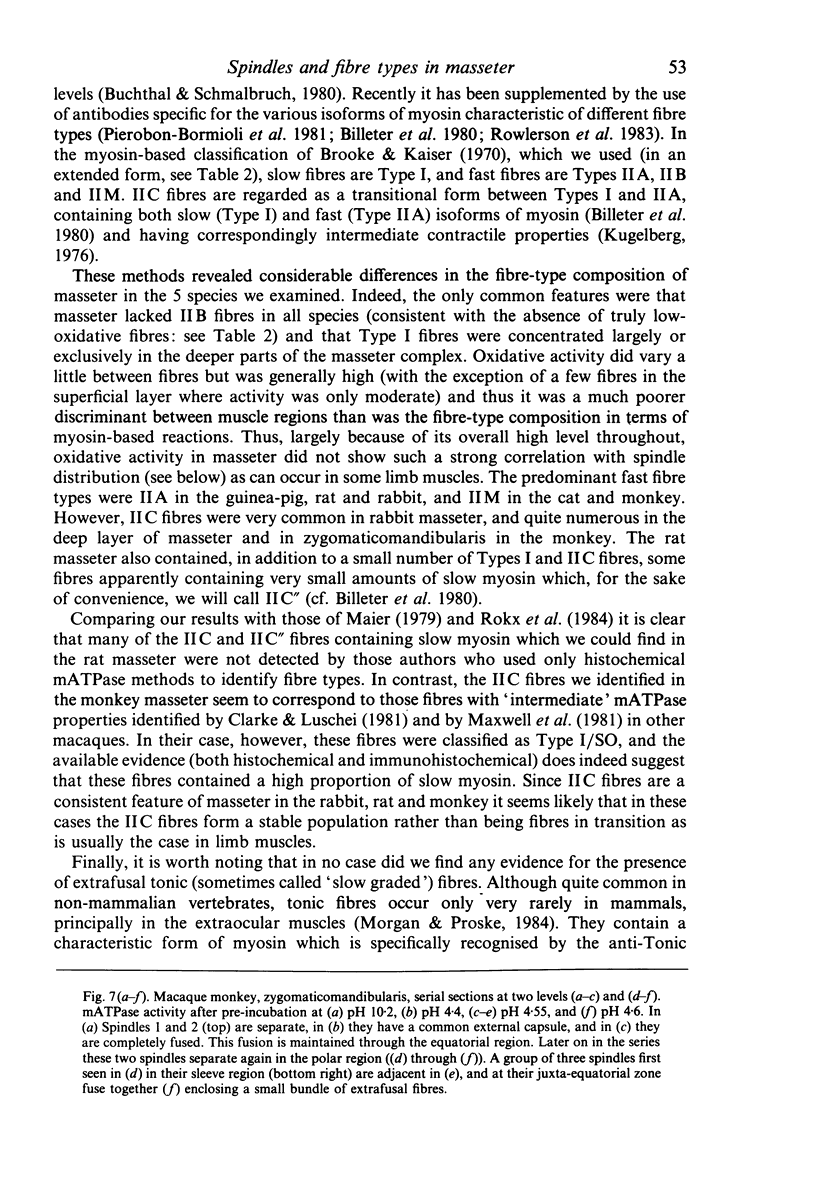
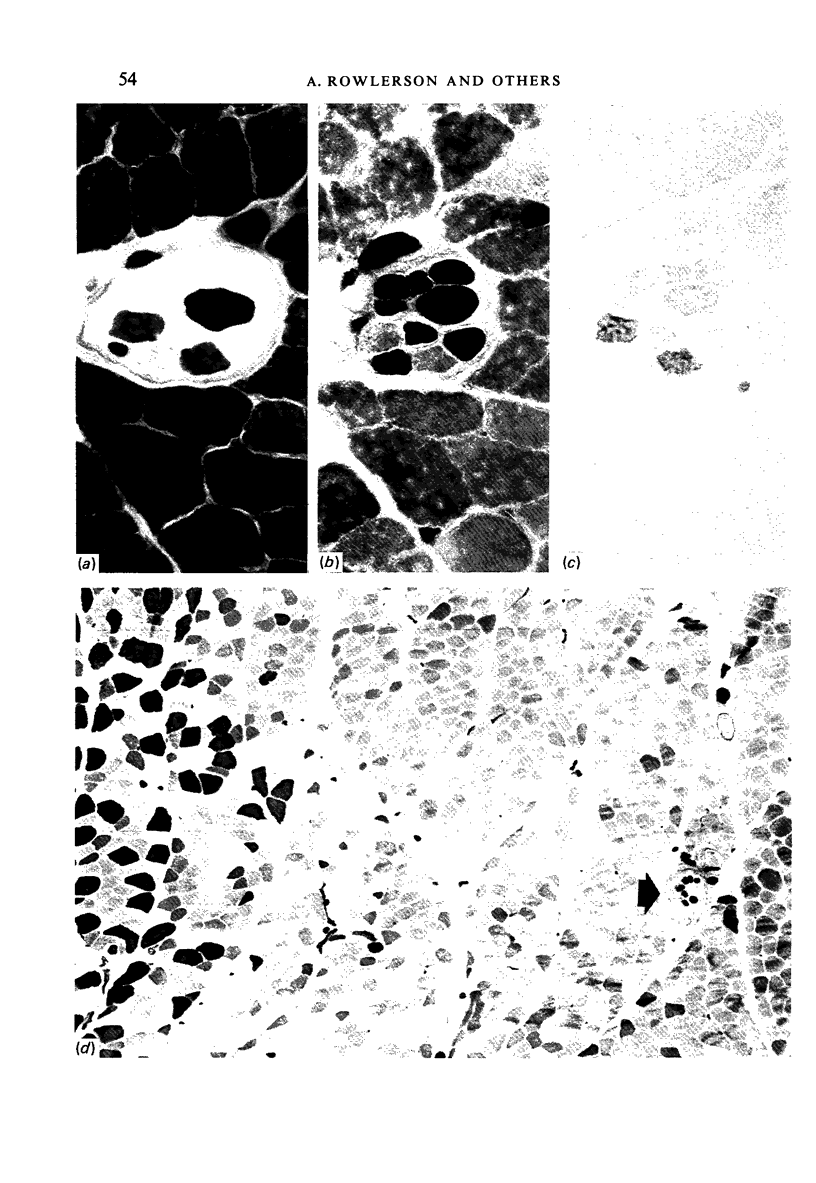
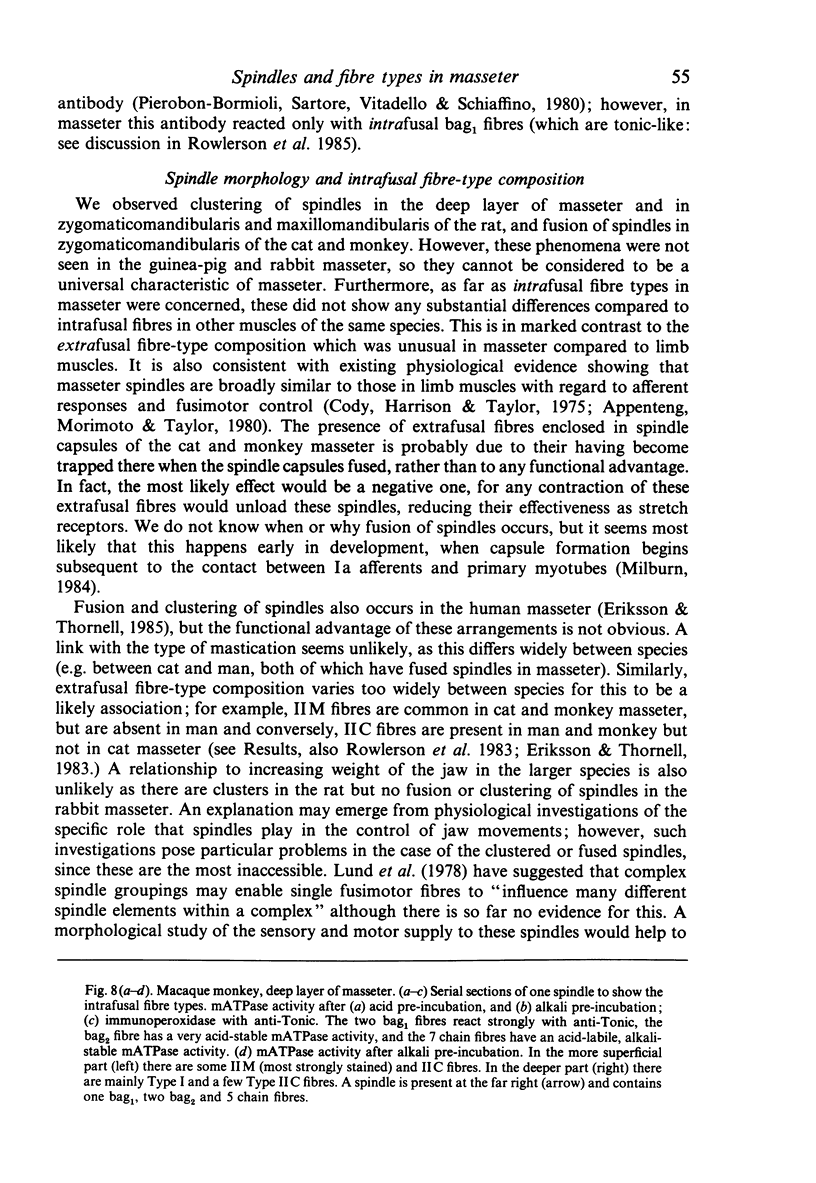
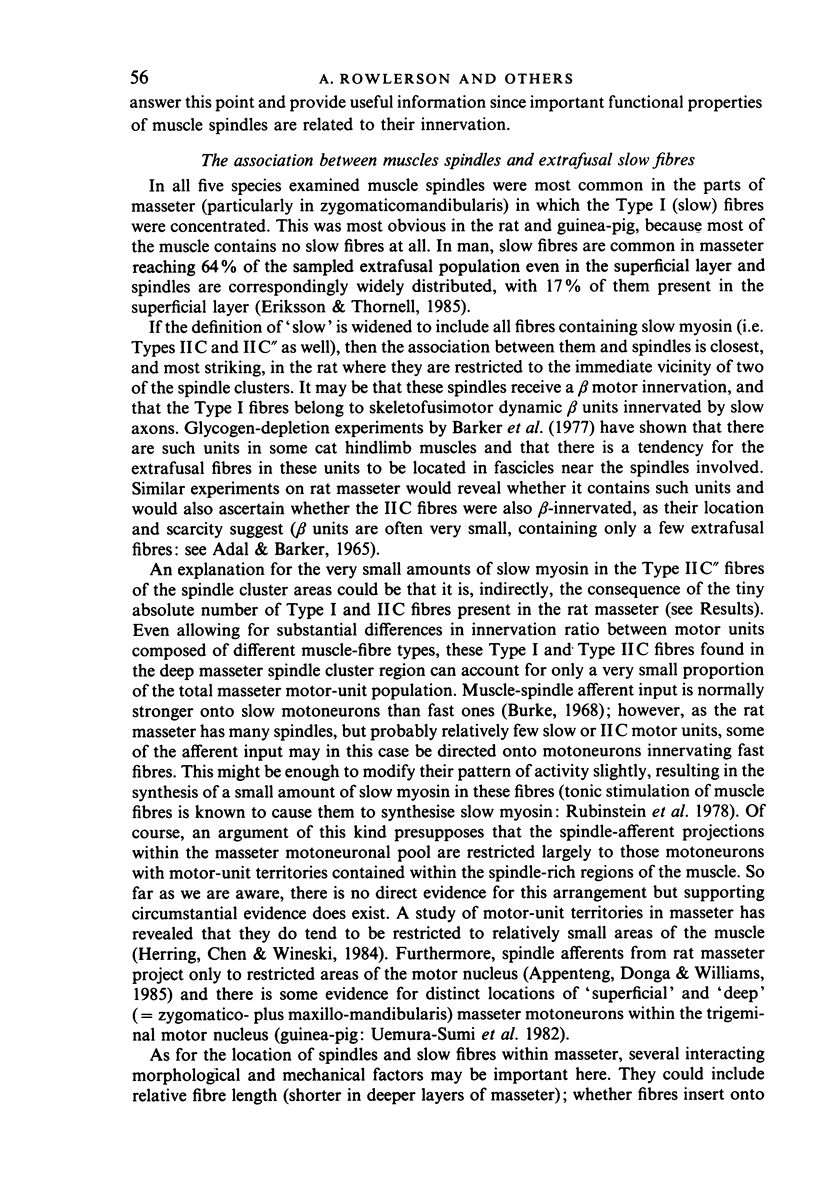
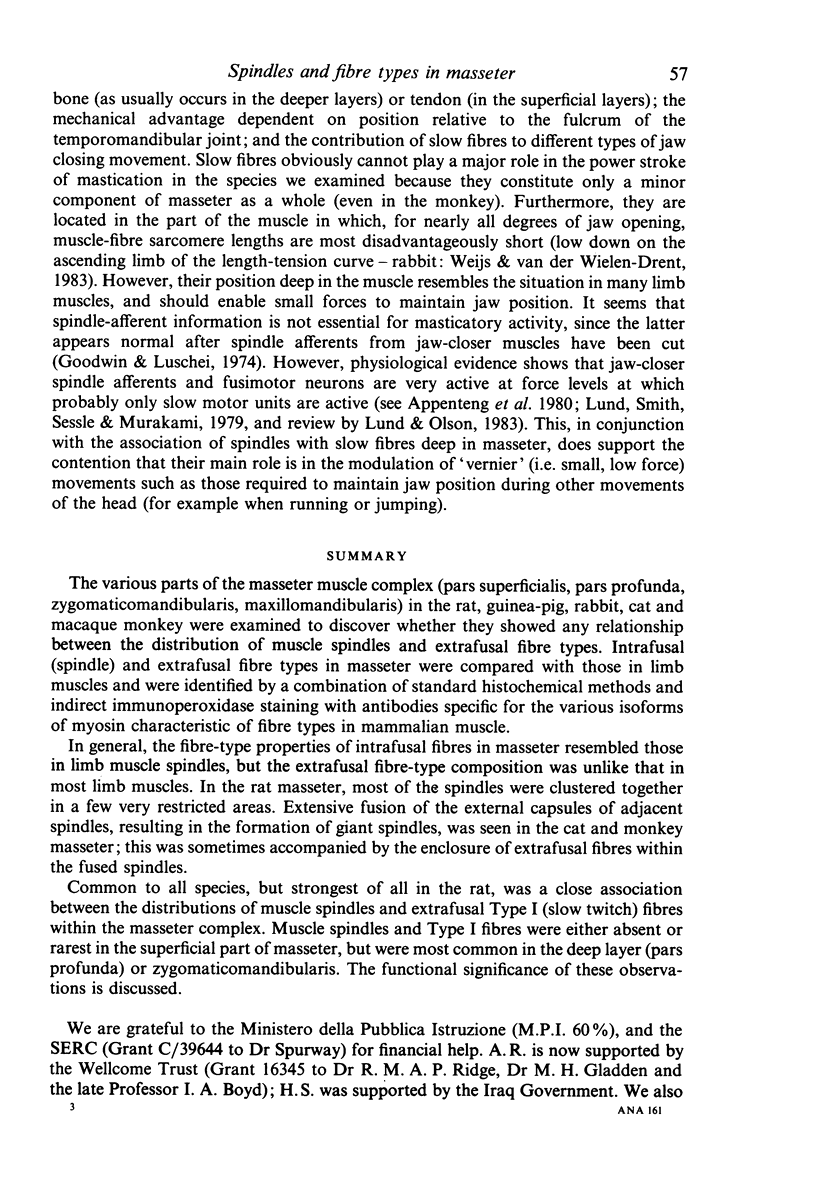
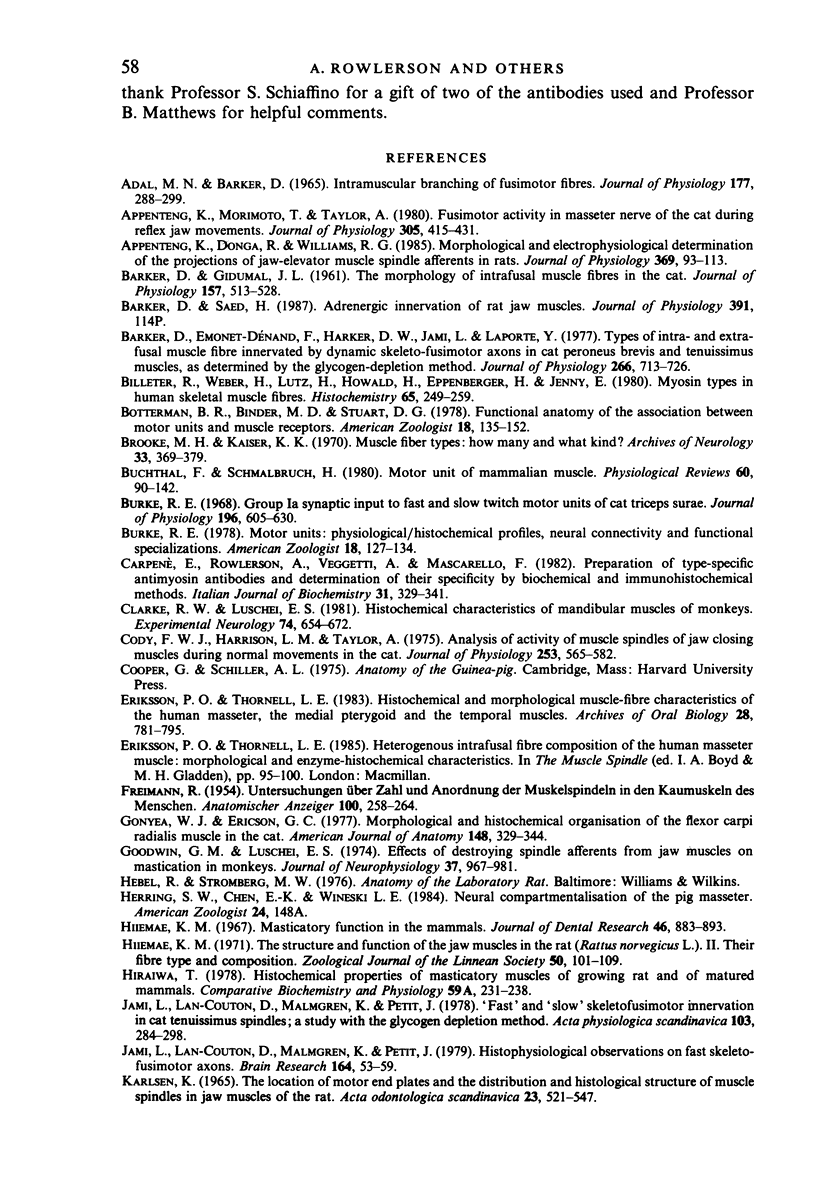
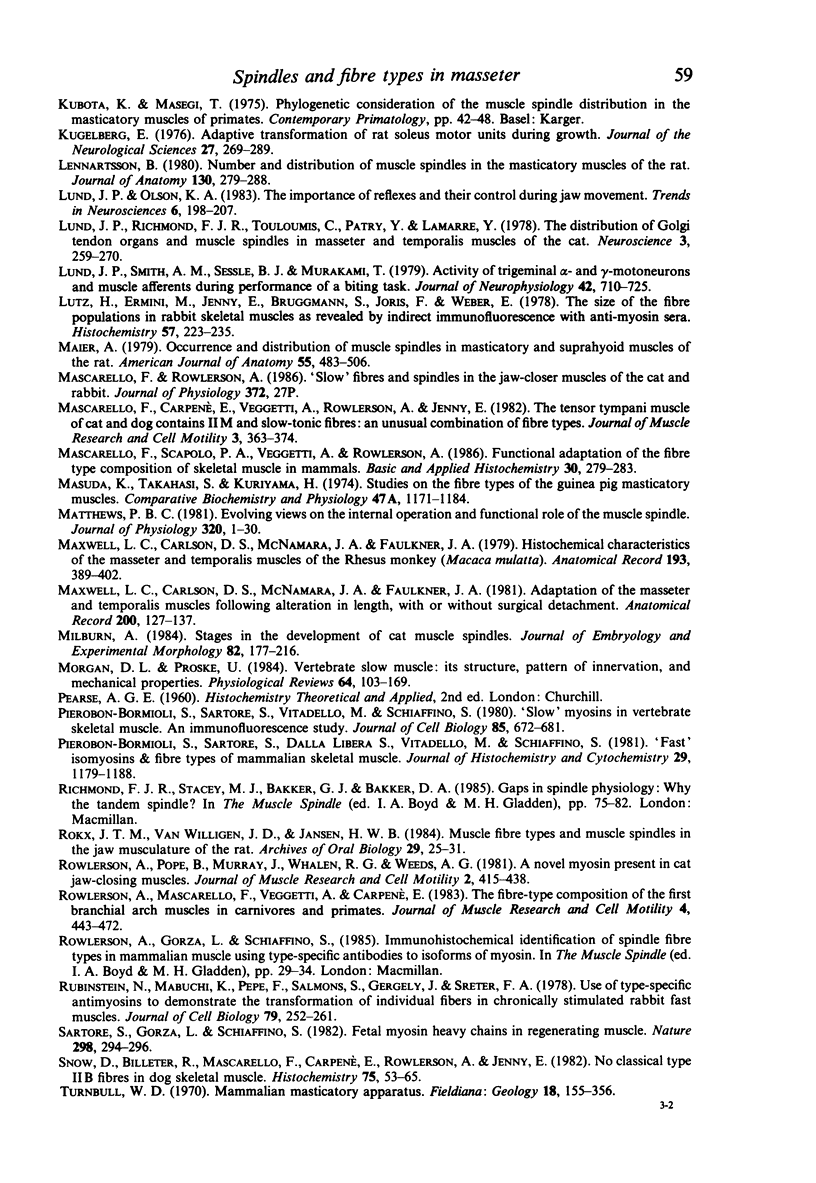
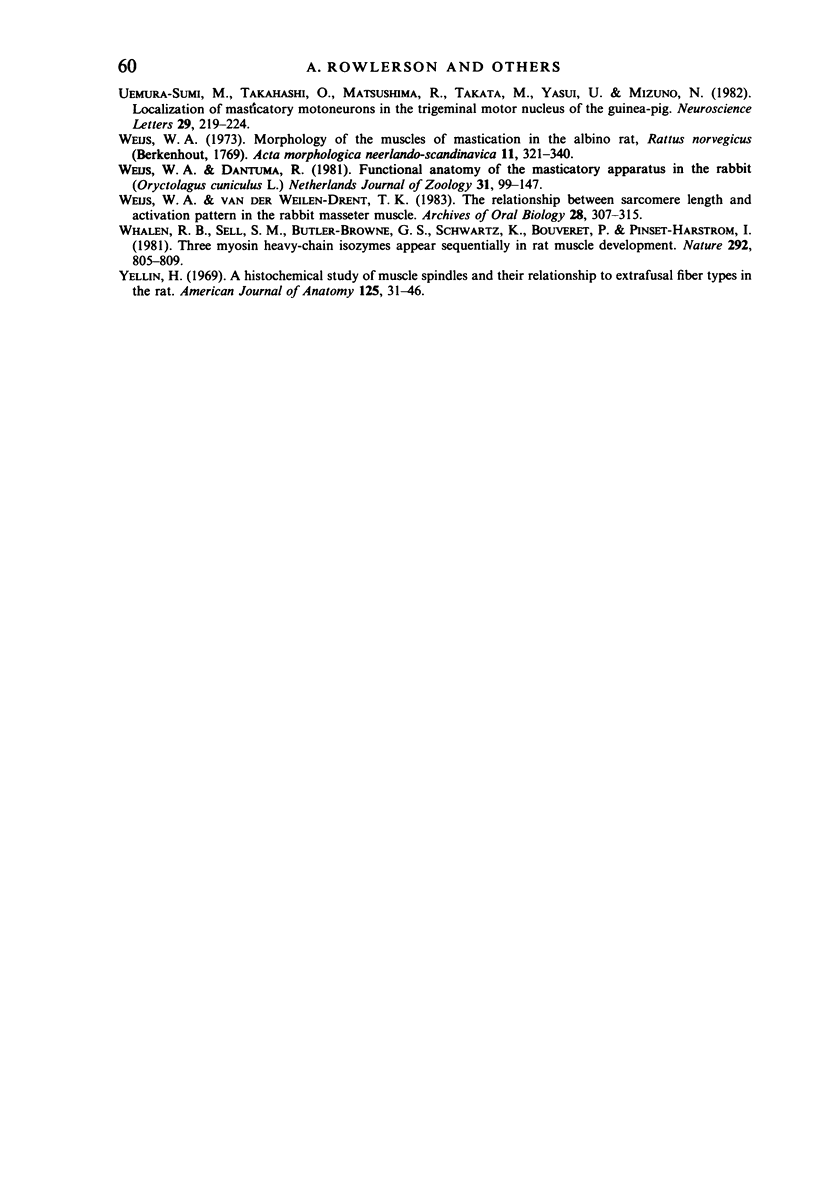
Images in this article
Selected References
These references are in PubMed. This may not be the complete list of references from this article.
- ADAL M. N., BARKER D. INTRAMUSCULAR BRANCHING OF FUSIMOTOR FIBRES. J Physiol. 1965 Mar;177:288–299. doi: 10.1113/jphysiol.1965.sp007592. [DOI] [PMC free article] [PubMed] [Google Scholar]
- Appenteng K., Donga R., Williams R. G. Morphological and electrophysiological determination of the projections of jaw-elevator muscle spindle afferents in rats. J Physiol. 1985 Dec;369:93–113. doi: 10.1113/jphysiol.1985.sp015890. [DOI] [PMC free article] [PubMed] [Google Scholar]
- Appenteng K., Morimoto T., Taylor A. Fusimotor activity in masseter nerve of the cat during reflex jaw movements. J Physiol. 1980 Aug;305:415–431. doi: 10.1113/jphysiol.1980.sp013373. [DOI] [PMC free article] [PubMed] [Google Scholar]
- BARKER D., GIDUMAL J. L. The morphology of intrafusal muscle fibres in the cat. J Physiol. 1961 Aug;157:513–528. doi: 10.1113/jphysiol.1961.sp006740. [DOI] [PMC free article] [PubMed] [Google Scholar]
- Barker D., Emonet-Dénand F., Harker D. W., Jami L., Laporte Y. Types of intra- and extrafusal muscle fibre innervated by dynamic skeleto-fusimotor axons in cat peroneus brevis and tenuissimus muscles, as determined by the glycogen-depletion method. J Physiol. 1977 Apr;266(3):713–726. doi: 10.1113/jphysiol.1977.sp011789. [DOI] [PMC free article] [PubMed] [Google Scholar]
- Billeter R., Weber H., Lutz H., Howald H., Eppenberger H. M., Jenny E. Myosin types in human skeletal muscle fibers. Histochemistry. 1980;65(3):249–259. doi: 10.1007/BF00493174. [DOI] [PubMed] [Google Scholar]
- Bormioli S. P., Sartore S., Vitadello M., Schiaffino S. "Slow" myosins in vertebrate skeletal muscle. An immunofluorescence study. J Cell Biol. 1980 Jun;85(3):672–681. doi: 10.1083/jcb.85.3.672. [DOI] [PMC free article] [PubMed] [Google Scholar]
- Brooke M. H., Kaiser K. K. Muscle fiber types: how many and what kind? Arch Neurol. 1970 Oct;23(4):369–379. doi: 10.1001/archneur.1970.00480280083010. [DOI] [PubMed] [Google Scholar]
- Buchthal F., Schmalbruch H. Motor unit of mammalian muscle. Physiol Rev. 1980 Jan;60(1):90–142. doi: 10.1152/physrev.1980.60.1.90. [DOI] [PubMed] [Google Scholar]
- Burke R. E. Group Ia synaptic input to fast and slow twitch motor units of cat triceps surae. J Physiol. 1968 Jun;196(3):605–630. doi: 10.1113/jphysiol.1968.sp008526. [DOI] [PMC free article] [PubMed] [Google Scholar]
- Carpenè E., Rowlerson A., Veggetti A., Mascarello F. Preparation of type-specific antimyosin antibodies and determination of their specificity by biochemical and immunohistochemical methods. Ital J Biochem. 1982 Sep-Oct;31(5):329–341. [PubMed] [Google Scholar]
- Clark R. W., Luschei E. S. Histochemical characteristics of mandibular muscles of monkeys. Exp Neurol. 1981 Dec;74(3):654–672. doi: 10.1016/0014-4886(81)90242-9. [DOI] [PubMed] [Google Scholar]
- Cody F. W., Harrison L. M., Taylor A. Analysis of activity of muscle spindles of the jaw-closing muscles during normal movements in the cat. J Physiol. 1975 Dec;253(2):565–582. doi: 10.1113/jphysiol.1975.sp011207. [DOI] [PMC free article] [PubMed] [Google Scholar]
- Eriksson P. O., Thornell L. E. Histochemical and morphological muscle-fibre characteristics of the human masseter, the medial pterygoid and the temporal muscles. Arch Oral Biol. 1983;28(9):781–795. doi: 10.1016/0003-9969(83)90034-1. [DOI] [PubMed] [Google Scholar]
- FREIMANN R. Untersuchungen über Zahl und Anordnung der Muskelspindeln in den Kaumuskeln des Menschen. Anat Anz. 1954 May 5;100(18-20):258–264. [PubMed] [Google Scholar]
- Gonyea W. J., Ericson G. C. Morphological and histochemical organization of the flexor carpi radialis muscle in the cat. Am J Anat. 1977 Mar;148(3):329–344. doi: 10.1002/aja.1001480304. [DOI] [PubMed] [Google Scholar]
- Goodwin G. M., Luschei E. S. Effects of destroying spindle afferents from jaw muscles on mastication in monkeys. J Neurophysiol. 1974 Sep;37(5):967–981. doi: 10.1152/jn.1974.37.5.967. [DOI] [PubMed] [Google Scholar]
- Hiiemäe K. M. Masticatory function in the mammals. J Dent Res. 1967 Sep-Oct;46(5):883–893. doi: 10.1177/00220345670460054601. [DOI] [PubMed] [Google Scholar]
- Jami L., Lan-Couton D., Malmgren K., Petit J. "Fast" and "slow" skeleto-fusimotor innervation in cat tenuissimus spindles; a study with the glycogen-depletion method. Acta Physiol Scand. 1978 Jul;103(3):284–298. doi: 10.1111/j.1748-1716.1978.tb06216.x. [DOI] [PubMed] [Google Scholar]
- Jami L., Lan-Couton D., Malmgren K., Petit J. Histophysiological observations on fast skeleto-fusimotor axons. Brain Res. 1979 Mar 23;164:53–59. doi: 10.1016/0006-8993(79)90005-2. [DOI] [PubMed] [Google Scholar]
- Karlsen K. The location of motor end plates and the distribution and histological structure of muscle spindles in jaw muscles of the rat. Acta Odontol Scand. 1965 Oct;23(5):521–547. doi: 10.3109/00016356509021768. [DOI] [PubMed] [Google Scholar]
- Kugelberg E. Adaptive transformation of rat soleus motor units during growth. J Neurol Sci. 1976 Mar;27(3):269–289. doi: 10.1016/0022-510x(76)90001-0. [DOI] [PubMed] [Google Scholar]
- Lennartsson B. Number and distribution of muscle spindles in the masticatory muscles of the rat. J Anat. 1980 Mar;130(Pt 2):279–288. [PMC free article] [PubMed] [Google Scholar]
- Lund J. P., Richmond F. J., Touloumis C., Patry Y., Lamarre Y. The distribution of Golgi tendon organs and muscle spindles in masseter and temporalis muscles of the cat. Neuroscience. 1978;3(2):259–270. doi: 10.1016/0306-4522(78)90107-0. [DOI] [PubMed] [Google Scholar]
- Lund J. P., Smith A. M., Sessle B. J., Murakami T. Activity of trigeminal alpha- and gamma-motoneurons and muscle afferents during performance of a biting task. J Neurophysiol. 1979 May;42(3):710–725. doi: 10.1152/jn.1979.42.3.710. [DOI] [PubMed] [Google Scholar]
- Lutz H., Ermini M., Jenny E. The size of the fibre populations in rabbit skeletal muscles as revealed by indirect immunofluorescence with anti-myosin sera. Histochemistry. 1978 Sep 15;57(3):223–235. doi: 10.1007/BF00492082. [DOI] [PubMed] [Google Scholar]
- Maier A. Occurrence and distribution of muscle spindles in masticatory and suprahyoid muscles of the rat. Am J Anat. 1979 Aug;155(4):483–505. doi: 10.1002/aja.1001550406. [DOI] [PubMed] [Google Scholar]
- Mascarello F., Carpenè E., Veggetti A., Rowlerson A., Jenny E. The tensor tympani muscle of cat and dog contains IIM and slow-tonic fibres: an unusual combination of fibre types. J Muscle Res Cell Motil. 1982 Sep;3(3):363–374. doi: 10.1007/BF00713043. [DOI] [PubMed] [Google Scholar]
- Mascarello F., Scapolo P. A., Veggetti A., Rowlerson A. Functional adaptation of the fibre type composition of skeletal muscle in mammals. Basic Appl Histochem. 1986;30(2):279–283. [PubMed] [Google Scholar]
- Masuda K., Takahaski S., Kuriyama H. Studies on the fibre types of the guinea pig masticatory muscles. Comp Biochem Physiol A Comp Physiol. 1974 Apr 1;47(4):1171–1184. doi: 10.1016/0300-9629(74)90091-7. [DOI] [PubMed] [Google Scholar]
- Matthews P. B. Evolving views on the internal operation and functional role of the muscle spindle. J Physiol. 1981 Nov;320:1–30. doi: 10.1113/jphysiol.1981.sp013931. [DOI] [PMC free article] [PubMed] [Google Scholar]
- Maxwell L. C., Carlson D. S., McNamara J. A., Jr, Faulkner J. A. Adaptation of the masseter and temporalis muscles following alteration in length, with or without surgical detachment. Anat Rec. 1981 Jun;200(2):127–137. doi: 10.1002/ar.1092000203. [DOI] [PubMed] [Google Scholar]
- Maxwell L. C., Carlson D. S., McNamara J. A., Jr, Faulkner J. A. Histochemical characteristics of the masseter and temporalis muscles of the rhesus monkey (Macaca mulatta). Anat Rec. 1979 Mar;193(3):389–402. doi: 10.1002/ar.1091930306. [DOI] [PubMed] [Google Scholar]
- Milburn A. Stages in the development of cat muscle spindles. J Embryol Exp Morphol. 1984 Aug;82:177–216. [PubMed] [Google Scholar]
- Morgan D. L., Proske U. Vertebrate slow muscle: its structure, pattern of innervation, and mechanical properties. Physiol Rev. 1984 Jan;64(1):103–169. doi: 10.1152/physrev.1984.64.1.103. [DOI] [PubMed] [Google Scholar]
- Pierobon-Bormioli S., Sartore S., Libera L. D., Vitadello M., Schiaffino S. "Fast" isomyosins and fiber types in mammalian skeletal muscle. J Histochem Cytochem. 1981 Oct;29(10):1179–1188. doi: 10.1177/29.10.7028858. [DOI] [PubMed] [Google Scholar]
- Rokx J. T., van Willigen J. D., Jansen H. W. Muscle fibre types and muscle spindles in the jaw musculature of the rat. Arch Oral Biol. 1984;29(1):25–31. doi: 10.1016/0003-9969(84)90038-4. [DOI] [PubMed] [Google Scholar]
- Rowlerson A., Mascarello F., Veggetti A., Carpene E. The fibre-type composition of the first branchial arch muscles in Carnivora and Primates. J Muscle Res Cell Motil. 1983 Aug;4(4):443–472. doi: 10.1007/BF00711949. [DOI] [PubMed] [Google Scholar]
- Rubinstein N., Mabuchi K., Pepe F., Salmons S., Gergely J., Sreter F. Use of type-specific antimyosins to demonstrate the transformation of individual fibers in chronically stimulated rabbit fast muscles. J Cell Biol. 1978 Oct;79(1):252–261. doi: 10.1083/jcb.79.1.252. [DOI] [PMC free article] [PubMed] [Google Scholar]
- Sartore S., Gorza L., Schiaffino S. Fetal myosin heavy chains in regenerating muscle. Nature. 1982 Jul 15;298(5871):294–296. doi: 10.1038/298294a0. [DOI] [PubMed] [Google Scholar]
- Snow D. H., Billeter R., Mascarello F., Carpenè E., Rowlerson A., Jenny E. No classical type IIB fibres in dog skeletal muscle. Histochemistry. 1982;75(1):53–65. doi: 10.1007/BF00492533. [DOI] [PubMed] [Google Scholar]
- Uemura-Sumi M., Takahashi O., Matsushima R., Takata M., Yasui Y., Mizuno N. Localization of masticatory motoneurons in the trigeminal motor nucleus of the guinea pig. Neurosci Lett. 1982 Apr 26;29(3):219–224. doi: 10.1016/0304-3940(82)90320-2. [DOI] [PubMed] [Google Scholar]
- Weijs W. A., van der Wielen-Drent T. K. The relationship between sarcomere length and activation pattern in the rabbit masseter muscle. Arch Oral Biol. 1983;28(4):307–315. doi: 10.1016/0003-9969(83)90073-0. [DOI] [PubMed] [Google Scholar]
- Whalen R. G., Sell S. M., Butler-Browne G. S., Schwartz K., Bouveret P., Pinset-Härstöm I. Three myosin heavy-chain isozymes appear sequentially in rat muscle development. Nature. 1981 Aug 27;292(5826):805–809. doi: 10.1038/292805a0. [DOI] [PubMed] [Google Scholar]
- Yellin H. A histochemical study of muscle spindles and their relationship to extrafusal fiber types in the rat. Am J Anat. 1969 May;125(1):31–45. doi: 10.1002/aja.1001250103. [DOI] [PubMed] [Google Scholar]



